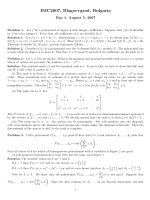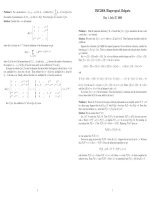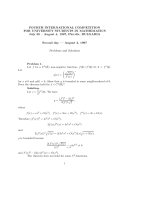Đề thi Olympic sinh viên thế giới năm 2007
Bạn đang xem bản rút gọn của tài liệu. Xem và tải ngay bản đầy đủ của tài liệu tại đây (138.73 KB, 7 trang )
IMC2007, Blagoevgrad, Bulgaria
Day 1, August 5, 2007
Problem 1. Let f be a polynomial of degree 2 with integer coefficients. Suppose that f(k) is divisible
by 5 for every integer k. Prove that all coefficients of f are divisible by 5.
Solution 1. Let f(x) = ax
2
+ bx + c. Substituting x = 0, x = 1 and x = −1, we obtain that 5|f(0) = c,
5|f(1) = (a + b + c) and 5|f (−1) = (a − b+ c). Then 5|f(1) + f(−1) − 2f(0) = 2a and 5|f (1) − f(−1) = 2b.
Therefore 5 divides 2a, 2b and c and the statement follows.
Solution 2. Consider f(x) as a polynomial over the 5-element field (i.e. modulo 5). The polynomial has
5 roots while its degree is at most 2. Therefore f ≡ 0 (mod 5) and all of its coefficients are divisible by 5.
Problem 2. Let n ≥ 2 be an integer. What is the minimal and maximal possible rank of an n × n matrix
whose n
2
entries are precisely the numbers 1, 2, . . . , n
2
?
Solution. The minimal rank is 2 and the maximal rank is n. To prove this, we have to show that the rank
can be 2 and n but it cannot be 1.
(i) The rank is at least 2. Consider an arbitrary matrix A = [a
ij
] with entries 1, 2, . . . , n
2
in some
order. Since permuting rows or columns of a matrix does not change its rank, we can assume that
1 = a
11
< a
21
< · · · < a
n1
and a
11
< a
12
< · · · < a
1n
. Hence a
n1
≥ n and a
1n
≥ n and at least one of these
inequalities is strict. Then det
a
11
a
1n
a
n1
a
nn
< 1 · n
2
− n · n = 0 so rk(A) ≥ rk
a
11
a
1n
a
n1
a
nn
≥ 2.
(ii) The rank can be 2. Let
T =
1 2 . . . n
n + 1 n + 2 . . . 2n
.
.
.
.
.
.
.
.
.
.
.
.
n
2
− n + 1 n
2
− n + 2 . . . n
2
The i
th
row is (1, 2, . . . , n)+ n(i− 1) · (1, 1, . . . , 1) so each row is in the two-dimensional subspace generated
by the vectors (1, 2, . . . , n) and (1, 1, . . . , 1). We already proved that the rank is at least 2, so rk(T ) = 2.
(iii) The rank can be n, i.e. the matrix can be nonsingular. Put odd numbers into the diagonal,
only even numbers above the diagonal and arrange the entries under the diagonal arbitrarily. Then the
determinant of the matrix is odd, so the rank is complete.
Problem 3. Call a polynomial P (x
1
, . . . , x
k
) good if there exist 2 × 2 real matrices A
1
, . . . , A
k
such that
P (x
1
, . . . , x
k
) = det
k
i=1
x
i
A
i
.
Find all values of k for which all homogeneous polynomials with k variables of degree 2 are good.
(A polynomial is homogeneous if each term has the same total degree.)
Solution. The possible values for k are 1 and 2.
If k = 1 then P (x) = αx
2
and we can choose A
1
=
1 0
0 α
.
If k = 2 then P (x, y) = αx
2
+ βy
2
+ γxy and we can choose matrices A
1
=
1 0
0 α
and A
2
=
0 β
−1 γ
.
Now let k ≥ 3. We show that the polynomial P (x
1
, . . . , x
k
) =
k
i=0
x
2
i
is not good. Suppose that
P (x
1
, . . . , x
k
) = det
k
i=0
x
i
A
i
. Since the first columns of A
1
, . . . , A
k
are linearly dependent, the first
1
IMC2007, Blagoevgrad, Bulgaria
Day 2, August 6, 2007
Problem 1. Let f : R → R be a continuous function. Suppose that for any c > 0, the graph
of f can be moved to the graph of cf using only a translation or a rotation. Does this imply that
f(x) = ax + b for some real numbers a and b ?
Solution. No. The function f(x) = e
x
also has this property since ce
x
= e
x+log c
.
Problem 2. Let x, y, and z be integers such that S = x
4
+ y
4
+ z
4
is divisible by 29. Show that S
is divisible by 29
4
.
Solution. We claim that 29 | x, y, z. Then, x
4
+ y
4
+ z
4
is clearly divisible by 29
4
.
Assume, to the contrary, that 29 does not divide all of the numbers x, y, z. Without loss of
generality, we can suppose that 29 ∤ x. Since the residue classes modulo 29 form a field, there is some
w ∈ Z such that xw ≡ 1 (mod 29). Then, (xw)
4
+ (yw)
4
+ (zw)
4
is also divisible by 29. So we can
assume that x ≡ 1 (mod 29).
Thus, we need to show that y
4
+ z
4
≡ −1 (mod 29), i.e. y
4
≡ −1 − z
4
(mod 29), is impossible.
There are only eight fourth powers modulo 29,
0 ≡ 0
4
,
1 ≡ 1
4
≡ 12
4
≡ 17
4
≡ 28
4
(mod 29),
7 ≡ 8
4
≡ 9
4
≡ 20
4
≡ 21
4
(mod 29),
16 ≡ 2
4
≡ 5
4
≡ 24
4
≡ 27
4
(mod 29),
20 ≡ 6
4
≡ 14
4
≡ 15
4
≡ 23
4
(mod 29),
23 ≡ 3
4
≡ 7
4
≡ 22
4
≡ 26
4
(mod 29),
24 ≡ 4
4
≡ 10
4
≡ 19
4
≡ 25
4
(mod 29),
25 ≡ 11
4
≡ 13
4
≡ 16
4
≡ 18
4
(mod 29).
The differences −1 − z
4
are congruent to 28, 27, 21, 12, 8, 5, 4, and 3. None of these residue classes
is listed among the fourth powers.
Problem 3. Let C be a nonempty closed bounded subset of the real line and f : C → C be a
nondecreasing continuous function. Show that there exists a point p ∈ C such that f(p) = p.
(A set is closed if its complement is a union of open intervals. A function g is nondecreasing if
g(x) ≤ g(y) for all x ≤ y.)
Solution. Suppose f(x) = x for all x ∈ C. Let [a, b] be the smallest closed interval that contains C.
Since C is closed, a, b ∈ C. By our hypothesis f(a) > a and f(b) < b. Let p = sup{x ∈ C : f(x) > x}.
Since C is closed and f is continuous, f(p) ≥ p, so f(p) > p. For all x > p, x ∈ C we have f(x) < x.
Therefore f
f(p)
< f(p) contrary to the fact that f is non-decreasing.
Problem 4. Let n > 1 be an odd positive integer and A = (a
ij
)
i,j=1...n
be the n × n matrix with
a
ij
=
2 if i = j
1 if i − j ≡ ±2 (mod n)
0 otherwise.
Find det A.
1
Solution. Notice that A = B
2
, with b
ij
=
1 if i − j ≡ ±1 (mod n)
0 otherwise
. So it is sufficient to find
det B.
To find det B, expand the determinant with respect to the first row, and then expad both terms
with respect to the first column.
det B =
0 1 1
1 0 1
1 0 1
1
.
.
.
.
.
.
.
.
.
0 1
1 0 1
1 1 0
= −
1 1
0 1
1
.
.
.
.
.
.
.
.
.
0 1
1 0 1
1 1 0
+
1 0 1
1 0 1
1
.
.
.
.
.
.
.
.
.
0 1
1 0
1 1
= −
0 1
1
.
.
.
.
.
.
.
.
.
0 1
1 0 1
1 0
−
1
0 1
1
.
.
.
.
.
.
.
.
.
0 1
1 0 1
+
1 0 1
1
.
.
.
.
.
.
.
.
.
0 1
1 0
1
−
0 1
1 0 1
1
.
.
.
.
.
.
.
.
.
0 1
1 0
= −(0 − 1) + (1 − 0) = 2,
since the second and the third matrices are lower/upper triangular, while in the first and the fourth
matrices we have row
1
− row
3
+ row
5
− · · · ± row
n−2
=
¯
0.
So det B = 2 and thus det A = 4.
Problem 5. For each positive integer k, find the smallest number n
k
for which there exist real
n
k
× n
k
matrices A
1
, A
2
, . . . , A
k
such that all of the following conditions hold:
(1) A
2
1
= A
2
2
= . . . = A
2
k
= 0,
(2) A
i
A
j
= A
j
A
i
for all 1 ≤ i, j ≤ k, and
(3) A
1
A
2
. . . A
k
= 0.
Solution. The anwser is n
k
= 2
k
. In that case, the matrices can be constructed as follows: Let V be
the n-dimensional real vector space with basis elements [S], where S runs through all n = 2
k
subsets
of {1, 2, . . . , k}. Define A
i
as an endomorphism of V by
A
i
[S] =
0 if i ∈ S
[S ∪ {i}] if i ∈ S
for all i = 1, 2, . . . , k and S ⊂ {1, 2, . . . , k}. Then A
2
i
= 0 and A
i
A
j
= A
j
A
i
. Furthermore,
A
1
A
2
. . . A
k
[∅] = [{1, 2, . . . , k}],
and hence A
1
A
2
. . . A
k
= 0.
Now let A
1
, A
2
, . . . , A
k
be n × n matrices satisfying the conditions of the problem; we prove that
n ≥ 2
k
. Let v be a real vector satisfying A
1
A
2
. . . A
k
v = 0. Denote by P the set of all subsets of
{1, 2, . . . , k}. Choose a complete ordering ≺ on P with the property
X ≺ Y ⇒ |X| ≤ |Y | for all X, Y ∈ P.
2
For every element X = {x
1
, x
2
, . . . , x
r
} ∈ P, define A
X
= A
x
1
A
x
2
. . . A
x
r
and v
X
= A
X
v. Finally,
write
¯
X = {1, 2, . . . , k} \ X for the complement of X.
Now take X, Y ∈ P with X Y . Then A
¯
X
annihilates v
Y
, because X Y implies the existence
of some y ∈ Y \ X = Y ∩
¯
X, and
A
¯
X
v
Y
= A
¯
X\{y}
A
y
A
y
v
Y \{y}
= 0,
since A
2
y
= 0. So, A
¯
X
annihilates the span of all the v
Y
with X Y . This implies that v
X
does not
lie in this span, because A
¯
X
v
X
= v
{1,2,...,k}
= 0. Therefore, the vectors v
X
(with X ∈ P) are linearly
independent; hence n ≥ |P| = 2
k
.
Problem 6. Let f = 0 be a polynomial with real coefficients. Define the sequence f
0
, f
1
, f
2
, . . . of
polynomials by f
0
= f and f
n+1
= f
n
+ f
′
n
for every n ≥ 0. Prove that there exists a number N such
that for every n ≥ N, all roots of f
n
are real.
Solution. For the proof, we need the following
Lemma 1. For any polynomial g, denote by d(g) the minimum distance of any two of its real
zeros (d(g) = ∞ if g has at most one real zero). Assume that g and g + g
′
both are of degree k ≥ 2
and have k distinct real zeros. Then d(g + g
′
) ≥ d(g).
Proof of Lemma 1: Let x
1
< x
2
< · · · < x
k
be the roots of g. Suppose a, b are roots of g + g
′
satisfying 0 < b − a < d(g). Then, a, b cannot be roots of g, and
g
′
(a)
g(a)
=
g
′
(b)
g(b)
= −1. (1)
Since
g
′
g
is strictly decreasing between consecutive zeros of g, we must have a < x
j
< b for some j.
For all i = 1, 2, . . . , k − 1 we have x
i+1
− x
i
> b − a, hence a − x
i
> b − x
i+1
. If i < j, both sides
of this inequality are negative; if i ≥ j, both sides are positive. In any case,
1
a−x
i
<
1
b−x
i+1
, and hence
g
′
(a)
g(a)
=
k−1
i=1
1
a − x
i
+
1
a − x
k
<0
<
k−1
i=1
1
b − x
i+1
+
1
b − x
1
>0
=
g
′
(b)
g(b)
This contradicts (1).
Now we turn to the proof of the stated problem. Denote by m the degree of f . We will prove
by induction on m that f
n
has m distinct real zeros for sufficiently large n. The cases m = 0, 1 are
trivial; so we assume m ≥ 2. Without loss of generality we can assume that f is monic. By induction,
the result holds for f
′
, and by ignoring the first few terms we can assume that f
′
n
has m − 1 distinct
real zeros for all n. Let us denote these zeros by x
(n)
1
> x
(n)
2
> · · · > x
(n)
m−1
. Then f
n
has minima
in x
(n)
1
, x
(n)
3
, x
(n)
5
, . . . , and maxima in x
(n)
2
, x
(n)
4
, x
(n)
6
, . . . . Note that in the interval (x
(n)
i+1
, x
(n)
i
), the
function f
′
n+1
= f
′
n
+ f
′′
n
must have a zero (this follows by applying Rolle’s theorem to the function
e
x
f
′
n
(x)); the same is true for the interval (−∞, x
(n)
m−1
). Hence, in each of these m − 1 intervals, f
′
n+1
has exactly one zero. This shows that
x
(n)
1
> x
(n+1)
1
> x
(n)
2
> x
(n+1)
2
> x
(n)
3
> x
(n+1)
3
> . . . (2)
Lemma 2. We have lim
n→∞
f
n
(x
(n)
j
) = −∞ if j is odd, and lim
n→∞
f
n
(x
(n)
j
) = +∞ if j is even.
Lemma 2 immediately implies the result: For sufficiently large n, the values of all maxima of f
n
are positive, and the values of all minima of f
n
are negative; this implies that f
n
has m distinct zeros.
3
Proof of Lemma 2: Let d = min{d(f
′
), 1}; then by Lemma 1, d(f
′
n
) ≥ d for all n. Define
ε =
(m − 1)d
m−1
m
m−1
; we will show that
f
n+1
(x
(n+1)
j
) ≥ f
n
(x
(n)
j
) + ε for j even. (3)
(The corresponding result for odd j can be shown similarly.) Do to so, write f = f
n
, b = x
(n)
j
, and
choose a satisfying d ≤ b − a ≤ 1 such that f
′
has no zero inside (a, b). Define ξ by the relation
b − ξ =
1
m
(b − a); then ξ ∈ (a, b). We show that f(ξ) + f
′
(ξ) ≥ f(b) + ε.
Notice, that
f
′′
(ξ)
f
′
(ξ)
=
m−1
i=1
1
ξ − x
(n)
i
=
i<j
1
ξ − x
(n)
i
<
1
ξ−a
+
1
ξ − b
+
i>j
1
ξ − x
(n)
i
<0
< (m − 1)
1
ξ − a
+
1
ξ − b
= 0.
The last equality holds by definition of ξ. Since f
′
is positive and
f
′′
f
′
is decreasing in (a, b), we have
that f
′′
is negative on (ξ, b). Therefore,
f(b) − f(ξ) =
b
ξ
f
′
(t)dt ≤
b
ξ
f
′
(ξ)dt = (b − ξ)f
′
(ξ)
Hence,
f(ξ) + f
′
(ξ) ≥ f(b) − (b − ξ)f
′
(ξ) + f
′
(ξ)
= f(b) + (1 − (ξ − b))f
′
(ξ)
= f(b) + (1 −
1
m
(b − a))f
′
(ξ)
≥ f (b) + (1 −
1
m
)f
′
(ξ).
Together with
f
′
(ξ) = |f
′
(ξ)| = m
m−1
i=1
|ξ − x
(n)
i
|
≥|ξ−b|
≥ m|ξ − b|
m−1
≥
d
m−1
m
m−2
we get
f(ξ) + f
′
(ξ) ≥ f(b) + ε.
Together with (2) this shows (3). This finishes the proof of Lemma 2.
b
a
ξ
f
′
f
f + f
′
4









